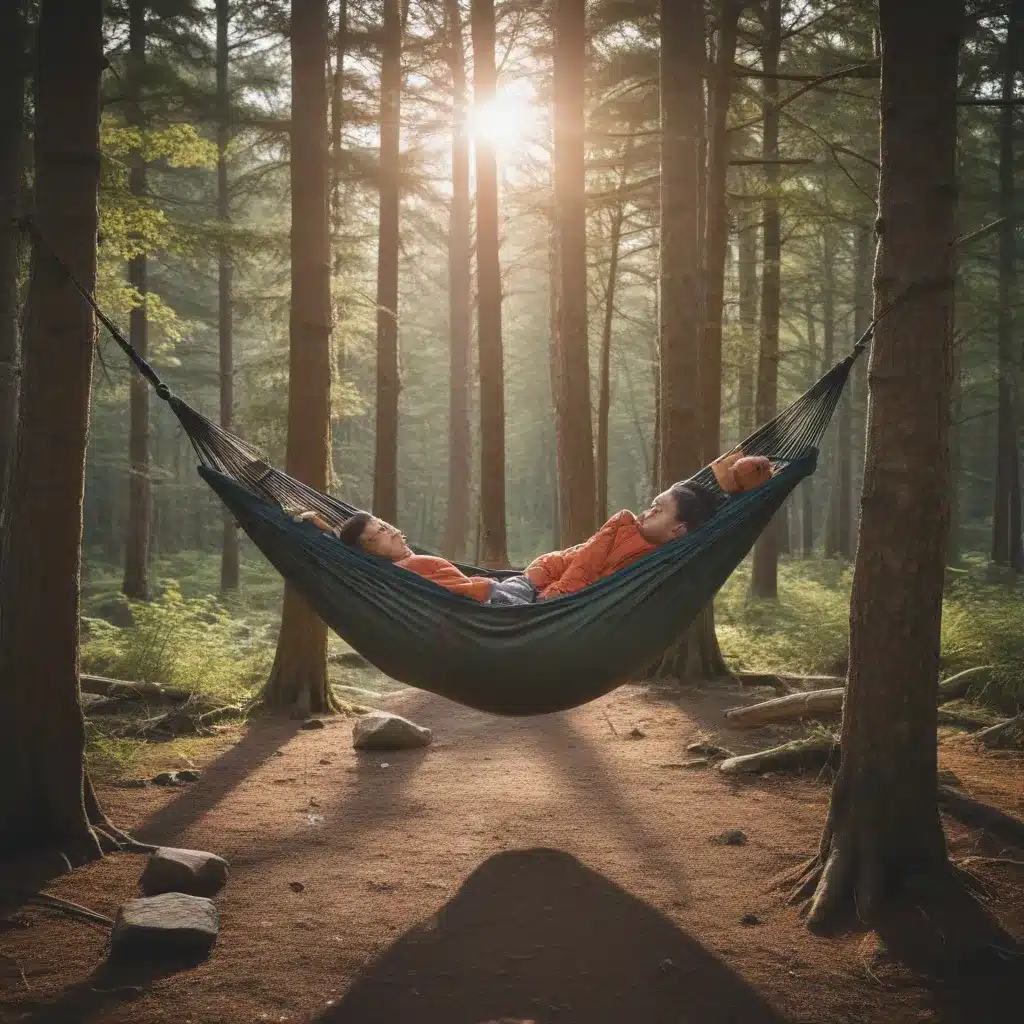
The Hammock Hang
As I stood there in the Scottish Highlands, gazing up at the towering pine trees, a mischievous grin spread across my face. You see, I had a secret weapon in my backpack – my trusty camping hammock. While the rest of my fellow campers were busy pitching their traditional tents, I knew I had something a little more… unconventional up my sleeve.
Now, I’ll admit, when I first heard about this whole “hammock camping” craze, I was a bit skeptical. How could those little nylon cocoons possibly be more comfortable than a good old-fashioned tent? But after my first night swaying gently between the trees, lulled to sleep by the gentle breeze, I was hooked.
The Pros of Hammock Camping
One of the biggest advantages of hammock camping, in my opinion, is the sheer flexibility it offers when it comes to finding a suitable campsite. Unlike traditional ground setups, a hammock could care less about the terrain beneath it. As long as I can find two sturdy trees spaced 12-18 feet apart, I’m good to go – no need to worry about finding a perfectly flat, rock-free patch of ground.
This means I can camp in all sorts of places that would be off-limits for a tent, like rocky hillsides, uneven forest floors, or even over small streams and bogs. It’s like having a portable, elevated oasis that I can set up just about anywhere. And let’s be real, who doesn’t love the idea of drifting off to sleep while suspended peacefully above the wilderness?
But the benefits of hammock camping don’t stop there. Many people, myself included, find sleeping in a hammock far more comfortable than the traditional ground setup. There’s just something about that gentle cradling sensation that lulls me into the deepest, most restorative sleep.
And let’s not forget the versatility factor. A hammock can double as a cozy reading nook or relaxation station during the day – no need to lug around a separate camp chair. Plus, when it’s time to pack up and hit the trail, the modular nature of a hammock system makes it a breeze to disassemble and stash away.
The Cons of Hammock Camping
Of course, no outdoor adventure is without its challenges, and hammock camping is no exception. One of the main drawbacks is the potential difficulty in finding suitable anchor points, especially in areas without abundant trees. While the Scottish Highlands are teeming with lush forests, there may be times when I have to get a bit creative with my setup.
Another potential issue is the added complexity of staying warm and cozy in my hammock, particularly during those chilly Scottish nights. Unlike a ground setup, where I can rely on insulation beneath me, a hammock leaves me more susceptible to heat loss from below. This means I’ll need to invest in some specialized gear like an underquilt or sleeping pad to prevent the dreaded “cold butt” syndrome.
And let’s not forget the social factor. Hammocks are generally designed for solo use, so if I’m out camping with a partner or group, we’ll need to coordinate our sleeping arrangements carefully. No more snuggling up in a cozy two-person tent!
Mastering the Hammock Setup
But fear not, fellow adventurers! Conquering the art of hammock camping is well within reach, even for the most novice outdoor enthusiasts. The basic setup involves little more than clipping a pair of sturdy nylon straps around two trees and then attaching your hammock. Within a matter of minutes, you can have your cozy haven suspended and ready for a night of serene slumber.
Of course, as with any camping system, there’s always room for customization and optimization. You might want to consider adding a tarp for weather protection, a bug net to keep those pesky midges at bay, or an underquilt to maintain a comfortable body temperature. And don’t forget the all-important ridgeline organizer – a must-have for keeping your essentials close at hand.
So, if you’re feeling adventurous and ready to take your camping game to new heights (pun intended), why not give hammock camping a try on your next visit to Loch Ness Shores? Who knows, you might just find yourself swaying gently between the trees, lost in the tranquility of the Scottish Highlands, dreaming of your next outdoor escapade.

